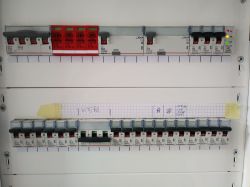Hello
There is a 5x2.5mm2 cable running from the box and the 3f fuse (3xB16). Later, in the kitchen box, another identical cable is connected to the island via WAGO.
Here in this box I want to leave with one phase for a 3kW electric oven.
The board on the island probably has a maximum capacity of 6kW and requires 2 phases - I will connect the remaining ones.
Is such uneven load distribution acceptable? Sometimes 3kW goes only on L3, sometimes 5kW goes on L1 and L2 and nothing on L3, etc.
One more question about connecting 2f induction, terminals L1 and L2 should have up to N up to 240V, do I connect any phases for induction (those apart from the oven) or do I take L1 - L2 from the fuse according to the markings and would it be good? And L3 will go to this oven.
Such a 3f fuse trips when I overload any phase above 20A, right?
Thanks a lot
There is a 5x2.5mm2 cable running from the box and the 3f fuse (3xB16). Later, in the kitchen box, another identical cable is connected to the island via WAGO.
Here in this box I want to leave with one phase for a 3kW electric oven.
The board on the island probably has a maximum capacity of 6kW and requires 2 phases - I will connect the remaining ones.
Is such uneven load distribution acceptable? Sometimes 3kW goes only on L3, sometimes 5kW goes on L1 and L2 and nothing on L3, etc.
One more question about connecting 2f induction, terminals L1 and L2 should have up to N up to 240V, do I connect any phases for induction (those apart from the oven) or do I take L1 - L2 from the fuse according to the markings and would it be good? And L3 will go to this oven.
Such a 3f fuse trips when I overload any phase above 20A, right?
Thanks a lot



